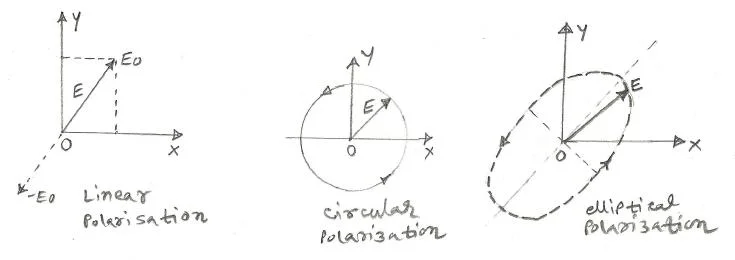Difference between linear vs circular vs elliptical polarization
Electromagnetic wave is said to be polarized in the direction of E(Electric field) vector. The polarization type vary based on variation of tip of E vector while propagation in the medium. The purpose of having different polarization is to make efficient use of spectrum using frequency re-use. Each type of polarization has its own unique characteristics and applications in various fields such as communication, radar, imaging and antenna design. Let us compare linear vs Circular vs elliptical polarized light and explore difference between linear, circular and elliptical polarization types.
Linear polarization
Polarization of the wave is called linear polarization when tip of E vector
describes a straight line with time.
Here, electric field oscillates in a single direction along a straight line.
This type is used for domestic/non-intelsat type of satellites.
Linear polarization will have two types viz. horizontal and vertical.
➨Refer advantages and disadvantages of Linear Polarization >>.
Examples:
➨A horizontally polarized antenna sends out electromagnetic waves with the electric field oscillating
horizontally.
➨Polarized sunglasses are designed to block light waves vibrating in certain orientations, allowing only light waves
vibrating in a specific direction to pass through. This reduces glare from surfaces like water or roads, which
predominantly reflect horizontally polarized light.

Circular polarization
Polarization of the wave is called Circular polarization when tip of E vector
describes a circle with time.
Here, electric field rotates in a circular manner perpendicular to the direction of propagation.
The wave is referred as circularly polarised plane wave.
It is used in Intelsat type of satellites.
In this circular type of polarised wave , E vector does not vary in intensity when it rotates.
Circular polarization will have two types viz. left hand circular polarization and right hand circular polarization.
➨Refer advantages and disadvantages of Circular Polarization >>.
Examples:
➨Circularly polarized antennas are commonly used in satellite communication and GPS systems.
These antennas emit waves that rotate either clockwise (right-handed) or counterclockwise (left-handed)
as they propagate.
➨Circular polarization is also used in 3D glasses for watching 3D movies. The glasses have lenses that allow only one type of circularly polarized light to pass through, ensuring that each eye sees a slightly different image, creating the illusion of depth.
Elliptical polarization
Polarization of the wave is called elliptical polarization when tip of E vector describes an ellipse with time. Here, the electric field traces an elliptical path. It is a combination of linear and circular polarization. In this type of polarization, E vector constantly changing both magnitude and direction. This wave is called elliptically polarised plane wave.
Examples:
➨Elliptically polarized waves are commonly used in radar systems for various applications
like weather monitoring and aircraft detection. The elliptical polarization allows for better
discrimination between different types of targets and reduces the effects of signal fading caused by reflections.
➨Medical imaging techniques like magnetic resonance imaging (MRI) use elliptically polarized radiofrequency
(RF) pulses to selectively excite specific tissues for imaging while minimizing interference from surrounding
structures.
Difference between linear circular and elliptical polarization
| Aspect | Linear Polarization | Circular Polarization | Elliptical Polarization |
|---|---|---|---|
| Orientation of Electric Field | Electric field oscillates in a single direction along a straight line. | Electric field rotates in a circular manner perpendicular to the direction of propagation. | Electric field traces an elliptical path, combining linear and circular polarization. |
| Representation | Can be represented as horizontal, vertical, or any angle in between. | Represented by a constant magnitude vector rotating at a constant rate. | Represented by an elliptical path traced by the electric field vector. |
| Types | Horizontal, vertical, diagonal, or any other angle. | Right-handed circular polarization (clockwise) or left-handed circular polarization (counterclockwise). | Right-handed elliptical polarization or left-handed elliptical polarization. |
| Transmission | Maintains its polarization orientation in free space propagation. | Changes polarization orientation periodically as it propagates. | Changes both orientation and magnitude of polarization as it propagates. |
| Impedance Matching | May require special consideration for impedance matching in certain applications. | Impedance matching is straightforward due to its constant polarization state. | May require more complex impedance matching due to changing polarization characteristics. |
| Conversion | Can be converted to other types using specific waveguides or components. | Can be converted to other types using appropriate components. | Can be converted to linear or circular polarization using various methods. |
| Applications | Commonly used in antennas, communication systems, and polarization-sensitive devices. | Used in satellite communication, GPS, and circularly polarized antennas. | Found in radar systems, medical imaging, and some communication systems. |
Conclusion : This comparison outlines the differences among linear, circular, and elliptical polarization in terms of their electric field orientation, representation, transmission behavior, applications, conversion methods, and impedance matching requirements. Each type of polarization offers unique advantages and is chosen based on the specific requirements of the application. Understanding the properties and behaviors of linear, circular, and elliptical polarizations is essential for designing and implementing various electromagnetic systems across a wide range of fields.
